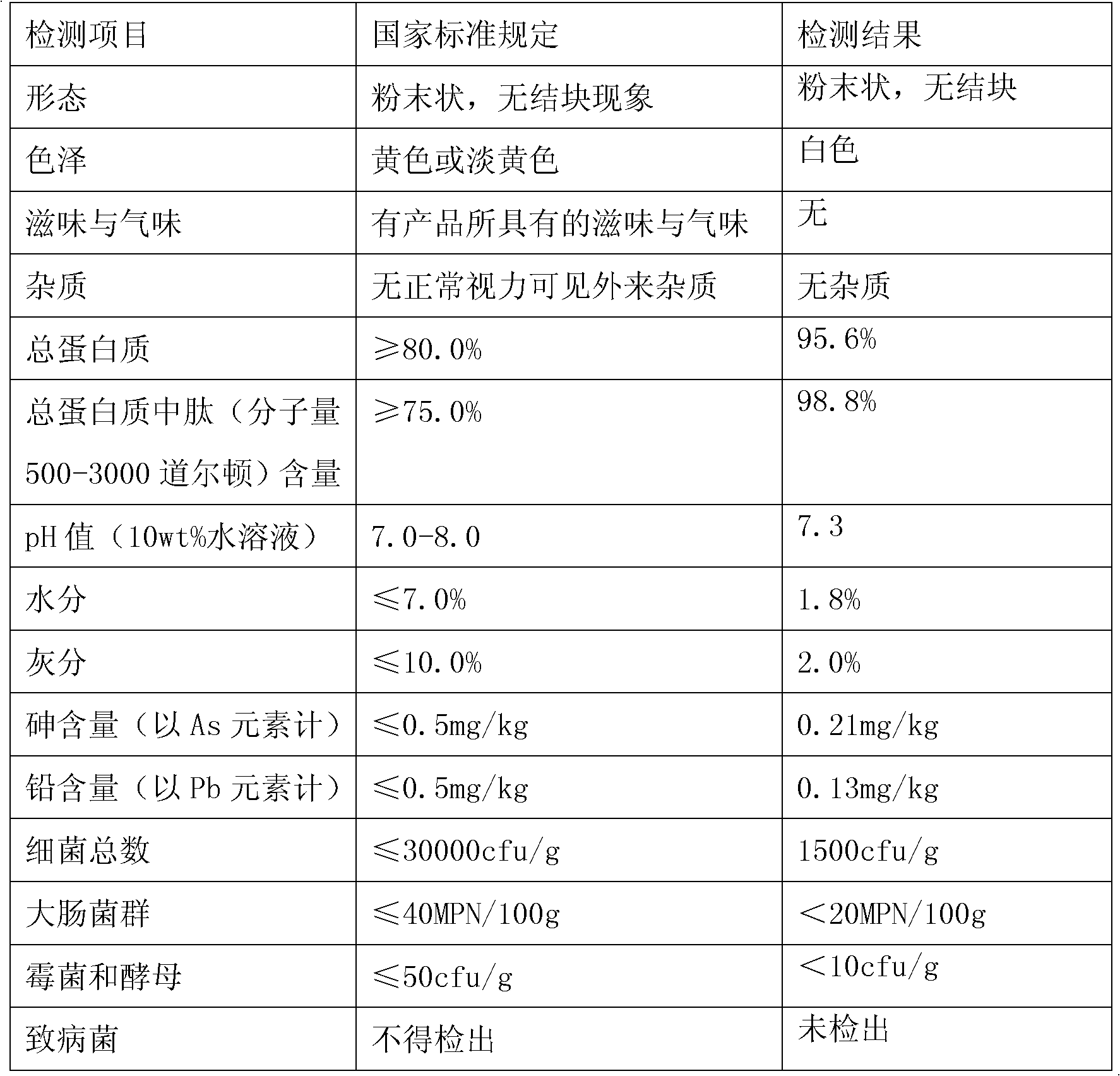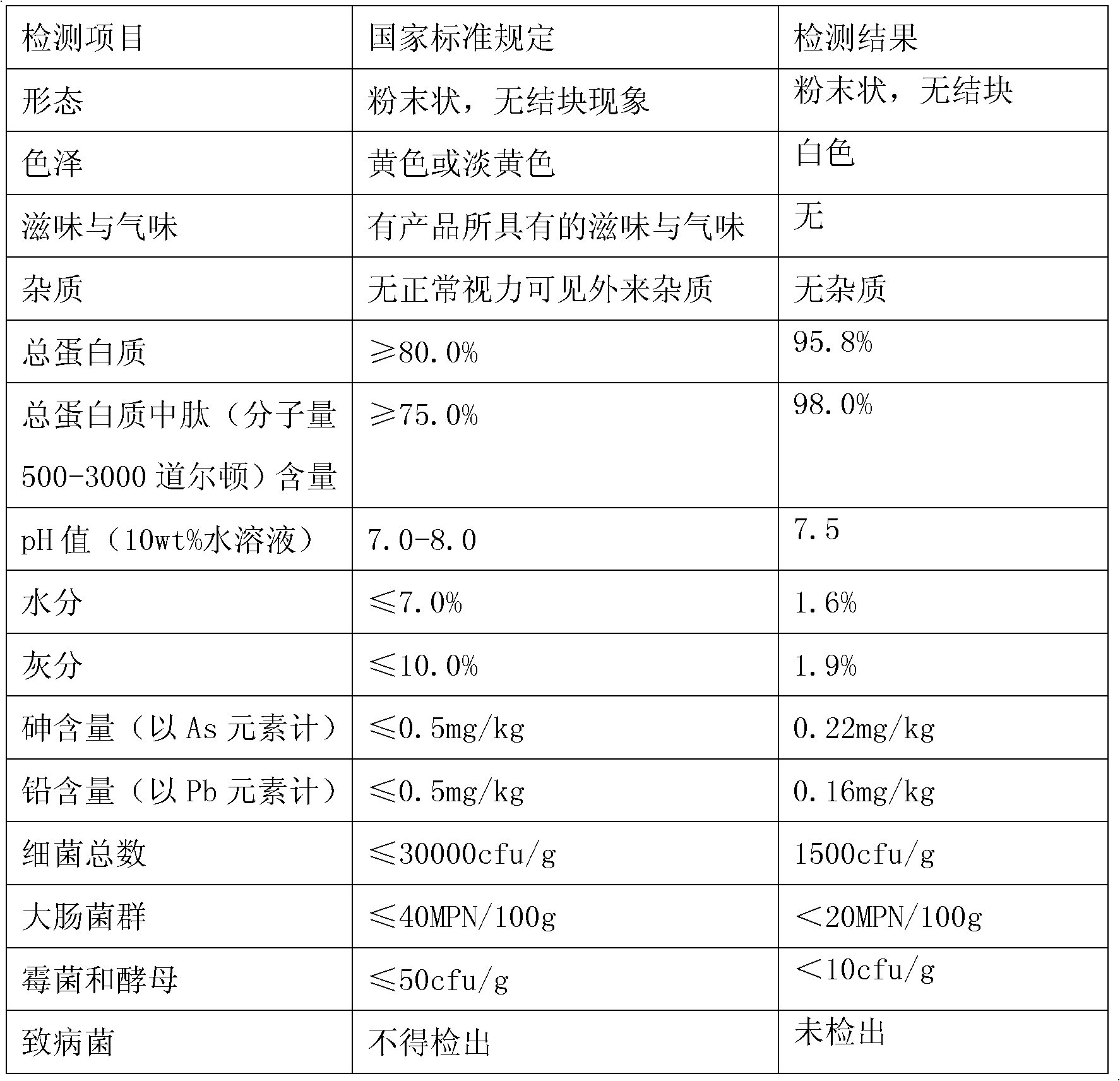Method for extracting pigskin collagen peptides
A technology of pigskin collagen and its extraction method is applied in the field of deep processing of pigskin, which can solve the problems of cumbersome operation and damage, and achieve the effects of high purity, short production cycle and easy absorption
- Summary
- Abstract
- Description
- Claims
- Application Information
AI Technical Summary
Problems solved by technology
Method used
Image
Examples
Embodiment 1
[0023] A method for extracting pigskin collagen peptides, the steps are as follows:
[0024] Weigh 1kg of fresh pigskin, wash it with 40°C water, add 7kg of pure water, then add 15g of anhydrous sodium sulfite, stir evenly, heat up to 100°C and reflux for 4 hours, then filter while it is hot; then cool the filtrate to 55°C, use 0.1M food-grade flake sodium hydroxide solution to adjust the pH to 7.5, add 30g lipase, keep the temperature at 55°C, stir for 8 hours, and use 0.1M food-grade flake sodium hydroxide solution to keep the pH value of the system stable during the reaction ; Then add 15g of alkaline protease, use 0.1M food-grade sodium hydroxide solution to keep the pH value of the reaction system at 7.5, keep the temperature at 55°C, and stir for 8 hours; Filtrate the solution to obtain a supernatant; add 20 g of powdered activated carbon to the supernatant, keep the temperature at 42°C for 1 hour, stir and absorb for decolorization, and filter out the activated carbon; ...
Embodiment 2
[0028] A method for extracting pigskin collagen peptides, the steps are as follows:
[0029] Weigh 2kg of fresh pigskin, wash it with water at 38°C, add 15kg of pure water, add 40g of anhydrous sodium sulfite, stir evenly, heat up to 100°C and reflux for 4 hours, then filter while it is hot; cool the filtrate to 60°C, and use Adjust the pH to 7 with 0.1M food-grade flake sodium hydroxide solution, add 50g of lipase, keep the temperature at 60°C, stir for 7 hours, and use 0.1M food-grade flake sodium hydroxide solution to keep the pH value of the system stable during the reaction ; Then add 40g of alkaline protease, keep the pH value of the reaction system at 7 with 0.1M food-grade flake sodium hydroxide solution, keep the temperature at 60°C, stir for 8 hours; then raise the temperature to 90°C, keep warm for 20min to kill the enzyme; Filtrate the solution to obtain a supernatant; add 40 g of powdered activated carbon to the supernatant, keep the temperature at 45°C for 1 hour...
Embodiment 3
[0033] A method for extracting pigskin collagen peptides, the steps are as follows:
[0034] Weigh 10kg of fresh pigskin, wash it with water at 45°C, add 90kg of pure water, add 160g of anhydrous sodium sulfite, stir evenly, heat up to 100°C and reflux for 5 hours, then filter while it is hot; cool the filtrate to 50°C, and use Adjust pH to 8 with 0.1M food-grade flake sodium hydroxide solution, add 280g lipase, keep the temperature at 50°C, stir for 9 hours, and use 0.1M food-grade flake sodium hydroxide solution to keep the pH value of the system stable during the reaction ; Then add 150g of alkaline protease, keep the pH value of the reaction system at 8 with 0.1M food-grade flake sodium hydroxide solution, keep the temperature at 50°C, and stir for 10 hours; Filtrate the solution to obtain a supernatant; add 220 g of powdered activated carbon to the supernatant, keep the temperature at 44°C, stir and adsorb for 1 hour to decolorize, and filter out the activated carbon; the...
PUM
 Login to View More
Login to View More Abstract
Description
Claims
Application Information
 Login to View More
Login to View More - R&D
- Intellectual Property
- Life Sciences
- Materials
- Tech Scout
- Unparalleled Data Quality
- Higher Quality Content
- 60% Fewer Hallucinations
Browse by: Latest US Patents, China's latest patents, Technical Efficacy Thesaurus, Application Domain, Technology Topic, Popular Technical Reports.
© 2025 PatSnap. All rights reserved.Legal|Privacy policy|Modern Slavery Act Transparency Statement|Sitemap|About US| Contact US: help@patsnap.com



